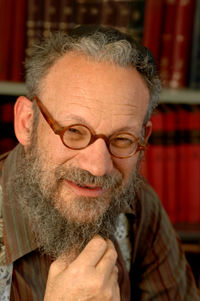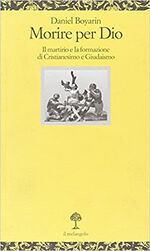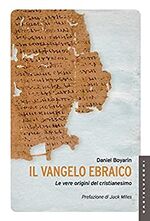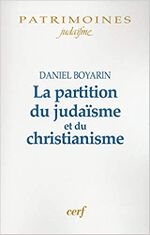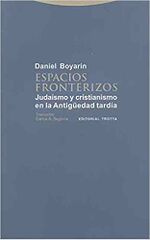Daniel Boyarin (M / United States, 1946), scholar
(Redirected from Daniel Boyarin)
Jump to navigation
Jump to search
Daniel Boyarin (b.1946) is a Jewish-American scholar, at the University of California (Berkeley, CA), USA. PhD (1975) at Jewish Theological Seminary. Taubman Professor of Talmudic Culture at the Dept. of Near Eastern Studies and Rhetoric, University of California at Berkeley.
-- 1990 --
Daniel Boyarin, A Radical Jew: Paul and the Politics of Identity (Berkeley, CA: University of California Press, 1994)
- <Daniel Boyarin turns to the Epistles of Paul as the spiritual autobiography of a first-century Jewish cultural critic. What led Paul--in his dramatic conversion to Christianity--to such a radical critique of Jewish culture? Paul's famous formulation, "There is neither Jew nor Greek, no male and female in Christ," demonstrates the genius of Christianity: its concern for all people. The genius of Judaism is its validation of genealogy and cultural, ethnic difference. But the evils of these two thought systems are the obverse of their geniuses: Christianity has threatened to coerce universality, while ethnic difference is one of the most troubled issues in modern history. Boyarin posits a "diaspora identity" as a way to negotiate the pitfalls inherent in either position. Jewishness disrupts categories of identity because it is not national, genealogical, or even religious, but all of these, in dialectical tension with one another. It is analogous with gender: gender identity makes us different in some ways but not in others. An exploration of these tensions in the Pauline corpus, argues Boyarin, will lead us to a richer appreciation of our own cultural quandaries as male and female, gay and straight, Jew and Palestinian--and as human beings.>--Publisher description.
- <As a (post)modern confessing and professing Orthodox Jew, Boyarin seeks not only to recover the historical meaning of Paul's message, but also to appropriate the apostle's social and cultural critique of first-century Judaism in order to address contemporary cultural issues of Jewish (and non-Jewish) identity in Western society. Boyarin contends that Paul was extremely disturbed by the particularism and ethnocentricity which he saw in Judaism, and advocated for the oneness of humanity in which Jewish difference was overridden but unity and univocity among Jews and Gentiles could be appreciated. Paul, motivated by a Hellenistic desire of the One, produced through platonist allegorization an ideal of an universal human essence, one lying beyond difference and hierarchy. For Boyarin, the advantage of such a theology lies in its universality and call for parity among Jew and Gentile. The downside remains in its ultimate call for the eradication of any real, bodily, corporeal (and Jewish)difference, the elimination of the Other, a political discourse which has dominated European Christian history and often violently translated itself into policies which have sought to destroy dominated minorities (e.g., Jews, Africans, Native Americans, etc.). Rabbinic Judaism, for its part, resisted Paul's (and the subsequent Christian) call for univocity, positively affirming the bodily difference of the Jew, inscribed nowhere else than on the circumcised male penis, which Paul had tried to allegorize into an ideal undifferentiated phallus. The strength of the rabbinic anti-thesis to Paul lies in its ability to value cultural difference, but its particularistic proclivities can also lead the Jew to neglect the Other and generate into a form of racism, especially if the Jewish people finds itself in a position of power as in the case of the revival of modern Jewish state. In order to avoid this danger, Boyarin argues that the state of Israel must ultimately be structured on individual and cultural rights, no longer coded as a Jewish state but as a bi-national, secular, and multicultural one in which Judaism will continue to exist but no longer dominate nor oppress the Other.>--Isaac W. Oliver, University of Michigan.
- Contents : Introduction: Wrestling with Paul -- 1. Circumcision, Allegory, and Universal "Man" -- 2. What was Wrong with Judaism? The Cultural Politics of Pauline Scholarship -- 3. The Spirit and the Flesh: Paul's Political Anthropology -- 4. Moses; Veil; or, The Jewish Letter, the Christian Spirit -- 5. Circumcision and Revelation; or, The Politics of the Spirit -- 6. Was Paul an "Anti-Semite"? -- 7. Brides of Christ: Jewishness and the Pauline Origins of Christian Sexual Renunciation -- 8. "There Is No Male and Female": Galatians and Gender Trouble -- 9. Paul, the "Jewish Problem," and the "Woman Question" -- 10. Answering the Mail: Toward a Radical Jewishness.
- Reviews : Neil Elliott, Review of Biblical Literature (2000)
Daniel Boyarin, Dying for God: Martyrdom and the Making of Christianity and Judaism (Stanford, CA: Stanford University Press, 1999)
- <Not long ago, everyone knew that Judaism came before Christianity. More recently, scholars have begun to recognize that the historical picture is quite a bit more complicated than that. In the Jewish world of the first century, many sects competed for the name of the true Israel and the true interpreter of the Torah?the Talmud itself speaks of seventy?and the form of Judaism that was to be the seedbed of what eventually became the Christian Church was but one of these many sects. Scholars have come to realize that we can and need to speak of a twin birth of Christianity and Judaism, not a genealogy in which one is parent to the other. In this book, the author develops a revised understanding of the interactions between nascent Christianity and nascent Judaism in late antiquity, interpreting the two ?new” religions as intensely and complexly intertwined throughout this period. Although the ?officials” of the eventual winners in both communities?the Rabbis in Judaism and the orthodox leaders in Christianity?sought to deny it, until the end of late antiquity many people remained both Christians and Jews. This resulted, among other things, in much shared religious innovation that affected the respective orthodoxies as well. Dying for God aims to establish this model as a realistic one through close and comparative readings of contemporary Christian texts and Talmudic narratives that thematize the connections and differences between Christians and Jews as these emerged around the issue of martyrdom. The author argues that, in the end, the developing discourse of martyrology involved the circulation and exchange of cultural and religious innovations between the two communities as they moved toward sharper self-definition.>--Publisher description.
- Contents : Introduction: When Christians were Jews: On Judeo-Christian Origins -- 1. The Close Call; or, Could a Pharisee be a Christian? -- 2. Quo Vadis?; or, The Acts of the Tricksters -- 3. Thinking with Virgins: Engendering Judeo-Christian Difference -- 4. Whose Martyrdom is this, Anyway? -- Appendix to Chapter 4: On the Methodology and Theology of W.H.C. Friend's Martyrdom and Persecution in the Early church.
- Translations : Italian (2008)
-- 2000 --
Daniel Boyarin, Border Lines: The Partition of Judaeo-Christianity (Philadelphia: University of Pennsylvania Press, 2004).
- <The historical separation between Judaism and Christianity is often figured as a clearly defined break of a single entity into two separate religions. Following this model, there would have been one religion known as Judaism before the birth of Christ, which then took on a hybrid identity. Even before its subsequent division, certain beliefs and practices of this composite would have been identifiable as Christian or Jewish.In Border Lines, however, Daniel Boyarin makes a striking case for a very different way of thinking about the historical development that is the partition of Judaeo-Christianity. There were no characteristics or features that could be described as uniquely Jewish or Christian in late antiquity, Boyarin argues. Rather, Jesus-following Jews and Jews who did not follow Jesus lived on a cultural map in which beliefs, such as that in a second divine being, and practices, such as keeping kosher or maintaining the Sabbath, were widely and variably distributed. The ultimate distinctions between Judaism and Christianity were imposed from above by "border-makers," heresiologists anxious to construct a discrete identity for Christianity. By defining some beliefs and practices as Christian and others as Jewish or heretical, they moved ideas, behaviors, and people to one side or another of an artificial border--and, Boyarin significantly contends, invented the very notion of religion.>--Publisher description.
- Contents : Preface: Interrogate, My Love -- 1. Introduction -- Part I: Making a Difference: The Heresiological Beginnings of Christianity and Judaism -- 2. Justin's Dialogue with the Jews: The Beginnings of Orthodoxy -- 3. Naturalizing the Border: Apostolic Succession in the Mishnah -- Part II: The Crucifixion of the Logos: How Logos Theology Became Christian -- 4. The Intertextual Birth of the Logos: The Prologue to John as a Jewish Midrash -- 5. The Jewish Life of the Logos: Logos Theology in Pre- and Pararabbinic Judaism -- 6. The Crucifixion of the Memra: How the Logos Became Christian -- Part III: Sparks of the Logos: Historicizing Rabbinic Religion -- 7. The Yavneh Legend of the Stammaim: On the Invention of the Rabbis in the Sixth Century -- 8. "When the Kingdom Turned to Minut ": The Christian Empire and the Rabbinic Refusal of Religion -- Concluding Political Postscript: A Fragment
- Reviews : Jed Wyrick, RBL
- Translations : German (2009) -- French (2011) -- Spanish (2013)
Italian ed. <Dying for God> : Daniel Boyarin, Morire per Dio: il martirio e la formazione di cristianesimo e giudaismo, tr. Paola Ursino and Paolo Mordechai Sciunnach (Genoa, Italy: Il Melangolo, 2008)
- "Fino a non molto tempo fa, era opinione comune credere che il giudaismo fosse nato prima del cristianesimo. Oggi gli studiosi riconoscono che il quadro storico è decisamente più complesso. Questo volume fornisce una nuova interpretazione dei rapporti tra nascente cristianesimo e nascente giudaismo, dimostrando che si trattò di un parto gemellare, e non di una genealogia in cui uno fu padre dell'altro. Attraverso una lettura comparata di testi cristiani e talmudici, l'autore fa emergere le affinità e le differenze tra cristiani ed ebrei in merito al concetto di martirio, mettendo in luce come gli intensi e complessi scambi culturali che legarono indissolubilmente le due "nuove" religioni contribuirono non poco a definire e a rafforzare le diverse identità di mondo ebraico e mondo cristiano."--Publisher description.
-- 2010 --
French ed. <Border Lines> : Daniel Boyarin, La partition du judaïsme et du christianisme, tr. Jacqueline Rastoin (Paris, France: Cerf, 2011)
- "Dans ce livre innovant, Daniel Boyarin met en cause le modèle d'une partition entre deux entités clairement distinctes qui seraient d'une part le judaïsme rabbinique et d'autre part le christianisme des Pères de l'Église. Il montre que la plupart des marqueurs de différence (l'idée d'une seconde hypostase divine, la théologie du Logos, ou les pratiques culturelles comme le shabbat ou le rôle des femmes) étaient partagés par des juifs et des chrétiens et récusés par certains juifs et certains chrétiens. Ce n'est qu'au cours d'un long processus volontaire des autorités naissantes de ces groupes que ces marqueurs d'identité sont devenus soit " juifs " soit " chrétiens " en excluant les dissidents qui avaient des pratiques ou des théologies hybrides. Le " concile " rabbinique, dit de Yavneh, comme en écho au concile chrétien de Nicée, a permis de situer dans le passé le moment de la " création " des concepts d'hérésie (ou minut pour le rabbinisme) et d'orthodoxie qui remontent en pratique au tournant du IIIe siècle. De part et d'autre de la frontière naissante, certains jouèrent le rôle de douaniers pour contrôler les identités ; certains aussi, et parfois les mêmes, étaient contrebandiers, faisant passer des concepts d'un côté à l'autre ; des deux côtés, les autorités cherchaient en effet à asseoir leur pouvoir et à rendre la frontière plus étanche..."--Publish description.
Daniel Boyarin, The Jewish Gospels: The Story of the Jewish Christ (New York, NY: New Press, distributed by Perseus Distribution, 2012)
- "Makes the powerful case that the conventional understandings of Jesus and the origins of Christianity are wrong: that Jesus' core teachings were not a break from Jewish beliefs and that Jesus was embraced by many Jews as the Messiah of the ancient Jewish texts." -- Publisher description.
- "In July 2008 a front-page story in the "New York Times" reported on the discovery of an ancient Hebrew tablet, dating from before the birth of Jesus, which predicted a Messiah who would rise from the dead after three days. Commenting on this startling discovery at the time, noted Talmud scholar Daniel Boyarin argued that "some Christians will find it shocking--a challenge to the uniqueness of their theology." Guiding us through a rich tapestry of new discoveries and ancient scriptures, "The Jewish Gospels" makes the powerful case that our conventional understandings of Jesus and of the origins of Christianity are wrong. In Boyarin's scrupulously illustrated account, the coming of the Messiah was fully imagined in the ancient Jewish texts. Jesus, moreover, was embraced by many Jews as this person, and his core teachings were not at all a break from Jewish beliefs and teachings. Jesus and his followers, Boyarin shows, were simply Jewish. What came to be known as Christianity came much later, as religious and political leaders sought to impose a new religious orthodoxy that was not present at the time of Jesus's life. In the vein of Elaine Pagels's "The Gnostic Gospels," here is a brilliant new work that will break open some of our culture's most cherished assumptions."--Publisher description.
- Contents : From son of God to son of man -- The son of man in First Enoch and Fourth Ezra: other Jewish messiahs of the first century -- Jesus kept kosher -- The suffering Christ as a midrash on Daniel -- Epilogue: the Jewish Gospel
- Translations : Italian (2012) -- French (2017)
Italian ed. <The Jewish Gospel> : Daniel Boyarin, Il Vangelo ebraico, tr. Simone Buttazzi (Rome, Italy: Castelvecchi, 2012)
- "Nel luglio del 2008 il "New York Times" pubblicava in prima pagina la notizia del ritrovamento di un'antica tavola ebraica, risalente a prima della nascita di Cristo, che riportava una profezia: l'annuncio di un Messia che sarebbe risorto tre giorni dopo la morte. È solo uno dei tasselli con cui Daniel Boyarin, fra i più importanti talmudisti viventi, ci spiega perché la storia del Nazareno non rappresenta, come da secoli si ritiene, un momento di rottura con il senso religioso ebraico. L'idea di un'incolmabile scissione teologica tra cristiani ed ebrei, diffusa tanto da una parte quanto dall'altra, dimentica una natura comune profondamente e radicalmente unitaria. Gesù era un ebreo osservante, un ebreo che mangiava kosher. Si era presentato nel modo in cui molti ebrei si aspettavano che facesse il Messia: un essere divino incarnato in un corpo umano. All'epoca dei fatti, del resto, la questione non era "Giungerà il Messia?", ma solo "Questo falegname di Nazareth è Colui che aspettavamo?". Alcuni credettero di sì, altri di no, e oggi noi chiamiamo il primo gruppo cristiani e il secondo ebrei, anche se, in principio, le cose non stavano così. Operando una sorprendente rilettura del Nuovo Testamento e avvalendosi delle più recenti scoperte e delle Antiche Scritture, Il Vangelo ebraico risale alle origini di una divisione millenaria che oggi, secondo Boyarin, dobbiamo avere il coraggio di capire e superare, andando oltre le convenzionali semplificazioni della Storia. Prefazione di Jack Milles."--Publisher description.
Spanish ed. <Border Lines> : Daniel Boyarin, Espacios Fronterizos: Judaísmo y cristianismo en la Antigüedad tardía, tr. Carlos Segovia (Madrid, Spain: Trotta, 2013)
- "Este libro explora la formación simultánea del cristianismo y del judaísmo rabínico como dos religiones independientes y la creación del concepto mismo de religión en la Antigüedad tardía. Aunando enfoques muy diversos (desde los nuevos estudios talmúdicos y el examen de la primitiva heresiología cristiana hasta la teoría poscolonial y el denominado nuevo historicismo, pasando por el análisis del judaísmo prerrabínico, los estudios neotestamentarios, la filosofía posestructuralista, la historiografía y la epistemología marxistas y la lingüística y la psicología contemporáneas), su autor defiende que eso que hoy se llama el «judaísmo rabínico» y el «cristianismo» no terminaron de formarse hasta aproximadamente el siglo v; y que lo hicieron mediante un proceso análogo al de la partición política de un único territorio religioso. Auténticos cartógrafos de la religión, los primitivos heresiólogos cristianos hicieron pasar ideas, conductas y gentes de un lado a otro de una frontera que ellos mismos fijaron con su discurso acerca de la especificidad del hecho religioso como fenómeno independiente de cualquier elemento étnico o lingüístico. Y los heresiólogos judíos hicieron lo propio, contribuyendo así unos y otros a dar forma a sus respectivas religiones y a la religión de quienes percibieron como sus adversarios. Al final de ese complejo y sinuoso proceso que se saldó con la consolidación del cristianismo como religión imperial, el judaísmo rabínico rechazó, paradójicamente, autodefinirse también él como religión: un rechazo cuyas implicaciones cabe percibir aún en nuestros días."--Publisher description.
French ed. <The Jewish Gospel> : Daniel Boyarin, Le Christ juif, tr. Marc Rastoin (Paris, France: Cerf, 2017)
- "Dans ce livre, je vais raconter l'histoire d'une époque où Juifs et chrétiens étaient beaucoup plus mélangés les uns avec les autres qu'ils ne le sont aujourd'hui. Une époque où il y avait beaucoup de Juifs qui croyaient en quelque chose de très similaire au Père et au Fils et même en quelque chose de très similaire à l'incarnation du Fils dans le Messie. Une époque où des disciples de Jésus mangeaient casher comme les Juifs, et en conséquence une époque où la question de la différence entre judaïsme et christianisme n'existait tout simplement pas comme aujourd'hui. Jésus, quand il vint, vint sous une forme que beaucoup, beaucoup de Juifs attendaient : une seconde figure divine incarnée en un humain. La question n'était pas : Un Messie divin doit-il venir ? mais elle était seulement : Ce charpentier de Nazareth est-il Celui que nous attendons ? Certains Juifs ont dit oui et d'autres non, ce qui n'est guère surprenant."--Daniel Boyarin.
